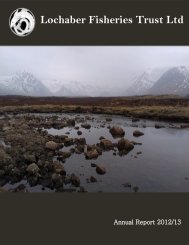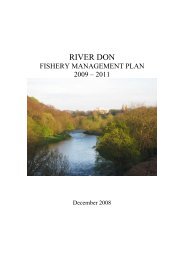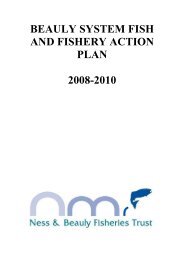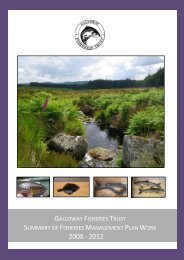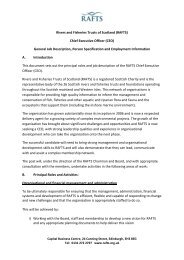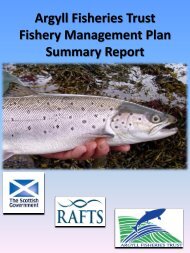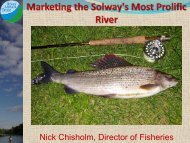Create successful ePaper yourself
Turn your PDF publications into a flip-book with our unique Google optimized e-Paper software.
River <strong>Annan</strong> DSFB Fisheries <strong>Management</strong> <strong>Plan</strong> 2009 – 20145.2.5 Protect Against Alien FloraJapanese knotweed Fallopia japonica varjaponica was introduced into the UK as anornamental garden plant in the mid-nineteenthcentury. It has since spread across the UK,particularly along watercourses, transport routesand infested waste areas. .The spread and high regeneration rates of theplant have serious implications for dispersal by both natural and human means.In river catchments, fragments of rhizomes or cut stems that are washed intowatercourses under high water flows can form new plants downstream. Flytippinggarden waste that contains stem or rhizome fragments, usingcontaminated topsoil and transporting soil from infested sites during constructionworks are the main ways that people spread the plant (Environment Agencywebsite).The vigorous growth of Japanese knotweed means it out-competes less resilientnative species of plant on watercourses. Control or eradication is difficult as theplant can regenerate from cut stems and tiny pieces of rhizome. If you aredealing with an isolated patch then constant pulling or cutting of the stems shouldwork by exhausting the rhizomes, but this may take several years. Any cutmaterial should be gathered up and placed on plastic sheeting to dry out until allsigns of life have gone. Digging out the rhizome is not recommended on a largescale as it produces too many fragments. Larger areas require repeatedherbicide treatment. Combined with controlled digging over, this can be veryeffective. Close to watercourses, the only two herbicides that can be used areapproved formulations of glyphosate or 2,4-D amine. The rhizome (undergroundstems), stems (above ground growth) and soils in which the plant grew must betaken to a landfill site. Dead stems may be left to rot down (DGS website).Himalayan or Indian balsam Impatiensglandulifera was introduced to Britain in1839, but escaped from gardens andrapidly colonised riverbanks and areasof damp ground. Himalayan balsamgrows in dense stands that suppress thegrowth of native grasses and other flora.In the autumn, the plants die back,leaving the banks bare of vegetationand vulnerable to erosion (EnvironmentAgency website).38




